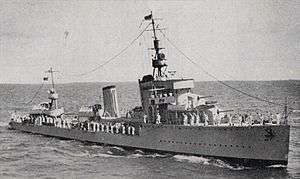Regele Ferdinand-class destroyer
 Regele Ferdinand | |
| Class overview | |
|---|---|
| Name: | Regele Ferdinand class |
| Builders: | Pattison, Naples |
| Operators: | |
| Preceded by: | Mărăști class |
| Planned: | 4 |
| Completed: | 2 |
| Cancelled: | 2 |
| Retired: | 2 |
| General characteristics | |
| Type: | Destroyer |
| Displacement: |
|
| Length: | 101.90 m (334 ft 4 in) |
| Beam: | 9.60 m (31 ft 6 in) |
| Draught: | 3.51 m (11 ft 6 in) |
| Propulsion: | 2 shaft Parsons type geared turbines, 4 Thornycroft type boilers, 36,000 kW (48,000 hp) |
| Speed: | 35 knots (65 km/h; 40 mph) |
| Range: | 3,000 nautical miles (5,600 km; 3,500 mi) at 15 knots (28 km/h; 17 mph) |
| Endurance: | 480 t oil |
| Complement: | 212 |
| Armament: |
|
The Regele Ferdinand class was two destroyers built in Italy for the Romanian Navy, which fought in World War II. Following the Soviet occupation of Romania in 1944, the two ships were seized and incorporated into the Soviet Black Fleet. They were returned to Romania in 1953 and served until the 1960s when they were scrapped.
Design and construction
Following the end of World War I and the re-purchase of two Mărăști-class destroyers from Italy, the Romanian Government decided to order two more modern destroyers from the Pattison Yard in Naples. The design was based on the British Shakespeare-class destroyer leaders. However they differed in that the turbines were in echelon layout.[1] The guns were supplied by Bofors and the fire control equipment by Siemens. The Romanians wished to order two more vessels but could not afford to do so due to economic problems.[1]
Specifications
The two ships of the Regele Ferdinand class were larger than their predecessors of the Mărăști class, being 101.90 metres (334 ft 4 in) long overall, with a beam of 9.60 metres (31 ft 6 in) and draught of 3.51 metres (11 ft 6 in). The displacements for the class were 1,400 long tons (1,400 t) standard and 1,850 long tons (1,880 t) at full load. They had a complement of 212.[1]
The vessels were powered by 4 Thornycroft type boilers giving an output of 36,000 kW (48,000 hp). This powered 2 shaft Parsons type geared turbines placed in echelon layout,[1] which gave the ships a maximum speed of 35 knots (65 km/h; 40 mph) and a range of 3,000 nautical miles (5,600 km; 3,500 mi) at 15 knots (28 km/h; 17 mph).
The ships were initially armed with five 120-millimetre (4.7 in) guns in single mounts as their main armament. One gun was later landed during a refit. For anti-aircraft defense, the two destroyers were initially given one 76-millimetre (3 in) gun and two 40-millimetre (1.6 in) guns in single mounts. They were also constructed with two 13-millimetre (0.5 in) machine guns. For anti-ship warfare, the destroyers were armed with six 533-millimetre (21 in) torpedo tubes mounted in two groups of three. The Regele Ferdinand-class vessels also had the capability to carry 50 mines.[1]
Ships
| Ship | Launched | Commissioned | Fate |
|---|---|---|---|
| Regele Ferdinand (RF) | 1 December 1928 | 7 September 1930 | Decommissioned in 1960s |
| Regina Maria (RM) | 2 March 1929 | 7 September 1930 | Decommissioned in 1960s |
Service history

The ships were the most powerful surface units available to the Axis powers during the Naval war in the Black Sea but were mostly used for convoy escort and in 1944 were used in the evacuation of the Crimea by the Axis.
On the capitulation of Romania to the Soviet Union in August 1944, the two ships were incorporated into the Soviet Black Sea Fleet as Likhoy (Лихой, ex-Regele Ferdinand) and Letuchiy (Летучий, ex-Regina Maria), formally commissioned on 20 October 1944.[2] They were returned in 1951 and served under the numbers D21 and D22 in Naval Forces of Romanian People's Republic until the end of 1950s.
See also
- Regele Ferdinand and Regina Maria frigates
- Romanian Naval Forces
References
Notes
Sources
- Chesneau, Roger, ed. (1980). Conway's All the World's Fighting Ships 1922–1946. Greenwich, UK: Conway Maritime Press. ISBN 0-85177-146-7.
- Monakov, Mikhail; Rohwer, Jurgen (2012). Stalin's Ocean-going Fleet: Soviet Naval Strategy and Shipbuilding Programs 1935-53. Routledge. ISBN 0714648957.
- Whitley, M.J. (1988). Destroyers of World War 2. Cassell Publishing. ISBN 1-85409-521-8.
External links
| Wikimedia Commons has media related to Regele Ferdinand class destroyer. |